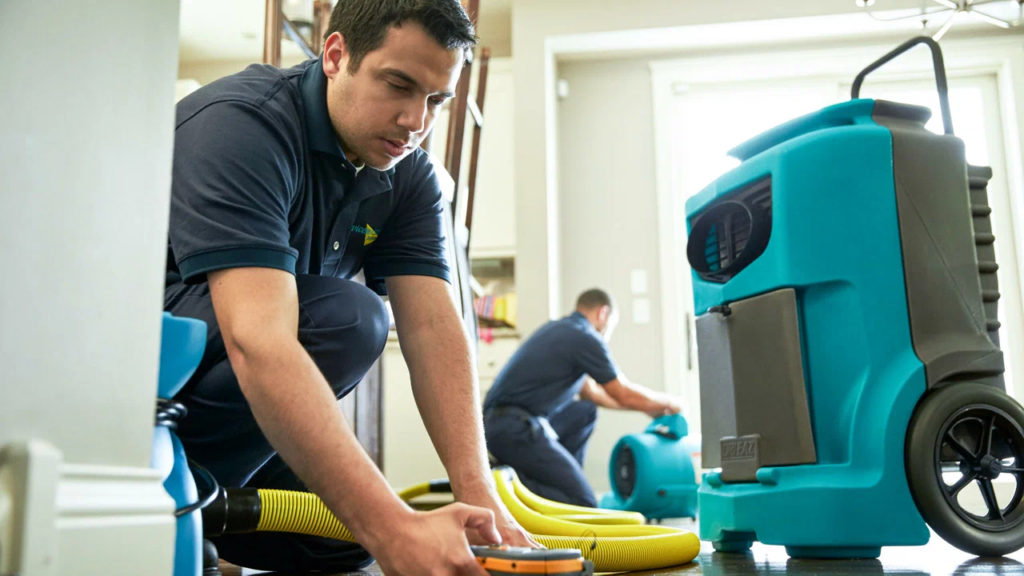
Water damage is one of the most common and destructive issues a property can face. Whether caused by a burst pipe, flooding, roof leak, or malfunctioning appliance, water can quickly compromise the structure of your home or business and lead to mold growth, electrical hazards, and serious property loss. When water damage occurs, quick and professional action is vital. That’s where water damage restoration comes into play.
But what exactly does the water damage restoration process involve? From the initial assessment to the final touches, restoration is a multi-step operation that requires skill, technology, and careful planning. Let’s walk through the entire process to understand what happens when professionals respond to water damage emergencies.
1. Emergency Contact and Initial Assessment
The restoration process begins the moment a property owner contacts a water damage restoration company. Most reputable companies offer 24/7 emergency services, understanding that time is critical when dealing with water damage.
Once on site, the restoration team performs an initial inspection and assessment. They identify the source of the water (clean, gray, or black water), determine the extent of the damage, and create a tailored restoration plan. Moisture detection tools like hygrometers, moisture meters, and infrared cameras may be used to assess hidden damage inside walls and under flooring.
The assessment is essential to form a strategy and to provide the property owner with a clear understanding of the damage and what to expect throughout the process.
2. Water Removal and Extraction
The next step is water removal, which is performed using powerful pumps and industrial-grade vacuums. This process starts as soon as possible to prevent the water from soaking deeper into floors, walls, and furnishings.
Water extraction typically involves:
- Submersible pumps for large volumes of water
- Truck-mounted or portable wet vacuums
- Specialized tools for carpet and padding removal
The faster the water is extracted, the more successful the drying and restoration efforts will be. Quick extraction helps minimize structural damage and reduces the chances of mold development.
3. Drying and Dehumidification
Even after standing water is removed, surfaces may still be damp, and hidden moisture can linger behind walls, in ceilings, or under flooring. If this moisture is not addressed properly, it can cause warping, swelling, mold, and rot.
That’s why the next critical phase is drying and dehumidification. Restoration professionals use high-speed air movers, industrial dehumidifiers, and other drying equipment to draw moisture from the structure and air.
The drying process can take several days depending on the severity of the water damage. Technicians monitor moisture levels using sensors and meters to ensure the property is completely dry before proceeding to the next step.
4. Cleaning and Sanitizing
Once everything is dry, it’s time to clean and sanitize the affected areas. Water damage often brings with it contaminants, bacteria, and potentially hazardous materials, especially in cases involving gray or black water.
This stage may include:
- Antimicrobial and antibacterial treatments
- Cleaning and disinfecting walls, floors, and furniture
- Odor removal using air scrubbers or fogging equipment
- Mold prevention treatments if necessary
Items that cannot be salvaged—like soaked drywall, insulation, or carpeting—are typically removed at this point. Any personal belongings or soft goods (clothing, upholstery, etc.) are cleaned offsite using specialized cleaning methods.

5. Mold Remediation (If Needed)
Mold can begin growing in as little as 24 to 48 hours after water exposure, especially in warm and humid environments. If mold is detected during the cleaning or drying stages, the restoration team will initiate mold remediation procedures.
This may involve isolating affected areas, using HEPA filters to trap spores, and safely removing mold-infested materials. Professional mold remediation ensures the air quality is restored and future growth is prevented.
6. Structural Repairs and Restoration
With everything cleaned and sanitized, the final phase involves reconstruction and restoration. This step restores the property to its pre-damage condition.
Depending on the extent of the damage, this may include:
- Replacing drywall and insulation
- Installing new flooring
- Painting walls and ceilings
- Rebuilding cabinets, countertops, or other built-ins
- Repairing or replacing damaged roofing or structural elements
Some water damage is minor and only requires cosmetic fixes, while severe cases may demand significant reconstruction. A quality restoration company will handle both the repair work and the necessary coordination with your insurance provider.
7. Insurance Claims Assistance
Navigating insurance claims can be overwhelming, especially in the wake of property damage. Many restoration companies offer support in dealing with insurance adjusters and documenting losses for claims.
They may provide:
- Detailed assessments and reports
- Photographic evidence of damage
- Inventory of damaged items
- Coordination with your insurance company for approvals
This support ensures that you receive the coverage you’re entitled to and helps speed up the claims process.

Conclusion
The water damage restoration process is a comprehensive and methodical approach to recovering a property after it has suffered from unwanted water intrusion. From the initial emergency call to the final repairs, each step is crucial in mitigating damage, preserving the integrity of the home, and ensuring the health and safety of its occupants. Skilled professionals use advanced equipment and follow industry-standard protocols to remove water, dry out the structure, sanitize the environment, and restore the property to its original condition. Taking swift action in the early stages can make a significant difference in the success of the restoration, helping to prevent long-term damage, mold growth, and costly repairs. Whether caused by a natural disaster or a plumbing mishap, water damage restoration is a process best left to experts who can restore peace of mind along with your property.


